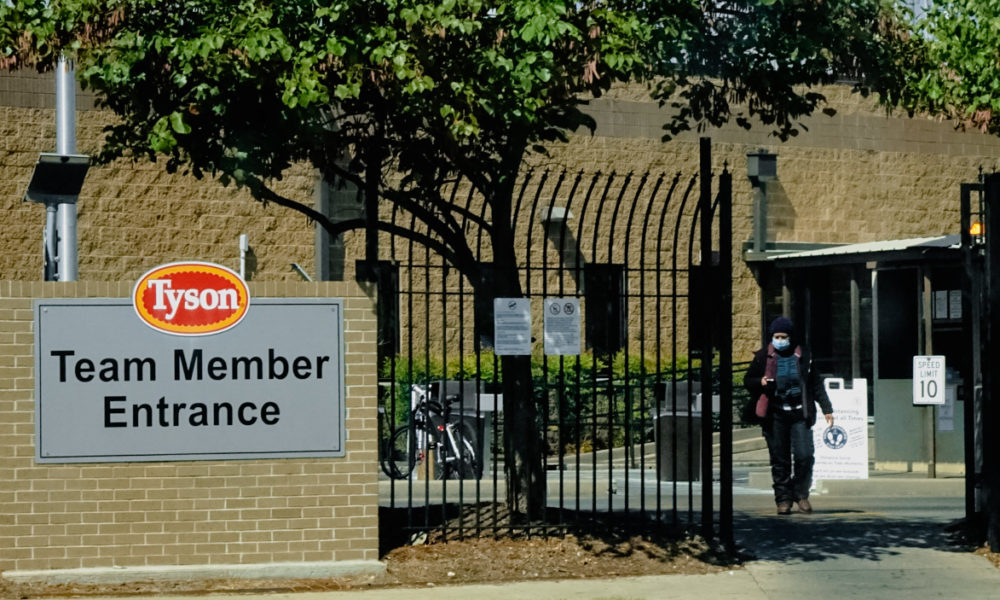Big corporations are often terrible bosses, especially for blue-collar workers on the low end of the pay scale. Many of the nation’s largest companies saw record profits in 2021, but year-end pay raises aren’t matching inflation. And while meat and poultry monster Tyson Foods raised some wages more substantially this year, it doesn’t begin to make up for the dangerous and dehumanizing conditions its frontline workers face.
2021: A good year for Tyson Foods, but not for its workers
It has been a very good year for Tyson Foods—at least financially speaking, which is how corporations tend to measure these things. The company’s fiscal year 2021 operating income, at $4.29 billion, was up 42 percent over 2020. Earnings for the fourth quarter of the year more than doubled over the same period in 2020. Shareholders received a cash dividend in December that was up more than 3 percent over the last one. And Tyson’s CEO (the company’s fifth in five years, who took the job after the previous guy left abruptly in June) took home a base salary of $1.2 million. His full compensation package is likely much, much more, though Tyson hasn’t yet released those details; for reference, the previous CEO raked in nearly $11 million in total 2020 compensation.
But are workers sharing in Tyson’s good times? The company has carried out a months-long PR blitz to make you think so. In September, it announced new starting wages of $15.20 an hour, which, according to a spokesperson, would reflect a substantial increase—nearly 22 percent. The pay raise garnered lots of local and national press. But Tyson’s latest annual report, quietly filed with the Securities and Exchange Commission in November, shows the company’s overall outlay for salaries, wages, and benefits over the course of fiscal year 2021—when workers needed every dollar—was a more modest 9 percent increase over the previous year.
In early December, Tyson announced a year-end bonus for frontline and hourly workers, trumpeting the total dollar value of $50 million. That sounds big until you realize it’s a considerably less eye-popping $300 to $700 per worker depending on tenure. Again Tyson got a lot of press, but careful readers will note the one-time nature of the bonus. A spokesman acknowledged the company hadn’t given one at the end of the pandemic’s first year, and it’s clear plant workers shouldn’t get used to it.
In explaining what led to the bonus, Tyson’s CEO said, “2021 presented many challenges.” Because 2020 was a walk in the park for Tyson workers, right?
No holiday bonus can make up for a job that might kill you
Of course, a bonus is a bonus. And $15.20 an hour is closer to a living wage than the federal ($7.25) or even Arkansas ($11) minimum. Still, it’s hard to argue that modestly higher pay compensates workers for the hazards they face in Tyson’s slaughtering and processing plants. After all, this is a company that knowingly subjects its frontline workers to a laundry list of horrors:
- According to an analysis of federal data from 2015-2016, Tyson ranked fourth among 14,000 US employers for frequency of severe injuries among workers, with 70 such injuries reported in the course of just 21 months.
- Tyson’s handling of the coronavirus at its plants allowed more than 29,000 of its US workers to contract COVID-19 and 151 of them to die in the first year of the pandemic.
- And Tyson managers lied to local public health officials and their own workers about COVID-19 in 2020—a new lawsuit alleges that they “explicitly forbid” interpreters from discussing the deadly virus with non-English-speaking workers at one Iowa plant, except to tell them it was not affecting the plant.
Let’s be clear about that last bit: Tyson’s lies and omissions didn’t just make workers less safe. They also precluded workers from making informed personal decisions about the level of risk they faced. Today, with Tyson’s negligence and abuses laid bare to the public, workers are better able to make those choices, and it’s no surprise that Tyson is having more trouble recruiting workers as a result.
Help wanted (dead or alive)
Tyson spokespeople have taken to saying that the company wants to be “the most sought-after place to work.” And somehow, they also still say with a straight face that safety is “always our top priority.” Clearly, they want to be perceived as benevolent and caring, even though they act more like Scrooge.
Make no mistake: there’s nothing generous about the one-time bonuses, free hot dogs for job applicants, or the small contribution toward worker childcare that the Tyson PR machine has boasted about lately. Tyson is trying to keep workers on the job, and lure new ones, because it needs them. Desperately.
But if Tyson’s execs think they are doing everything they can to make the company a better employer, they should think harder. Trivial gestures are not what workers want or need. They need real workplace health and safety protections such as PPE, slower line speeds, social distancing, and paid sick time, as worker-rights advocates have long demanded. Tyson doesn’t want to provide these—to fix the actual problems that have gotten startling numbers of its workers killed, sickened, or disfigured in recent years—because that would necessarily cut into the big profits enjoyed by its executives and shareholders.
Perhaps Tyson executives don’t think first about investing in real protections and meaningfully better pay and working conditions because they think of workers as mere cogs in the wheel—the means to achieving those big profits, rather than as people.
For example, here’s the way Tyson’s annual report describes how COVID-19 affects its business:
If a significant percentage of our workforce is unable to work, including because of illness, travel or government restrictions in connection with COVID-19, this could have an adverse effect on our operations and results of operations. In addition, certain of our team members who claim to have tested positive for COVID-19, or their family members, have filed lawsuits seeking compensatory and punitive damages for wrongful death and personal injury claims in several states. We expect additional team members or family members of team members may assert similar claims as the COVID-19 pandemic continues. If we are unsuccessful in defending against such claims, we may experience significant losses and expenses in connection with these lawsuits, which could adversely affect our liquidity, results of operations and financial condition.
Really? Team members who claim to have tested positive? Maybe, just maybe, instead of doubting sick workers and bemoaning wrongful death and injury lawsuits, Tyson could get to the root of the problem with more steps to make its operations safer.
Instead, it has sought to dodge responsibility. At its shareholder meeting in February 2021, major shareholders from the Tyson family overwhelmingly voted down a resolution asking the company to produce a “human rights due diligence report.” It was the third year in a row they’d shot down such a resolution, though the request was gaining support from independent investors. In late 2021, anticipating the resolution would come back again in 2022, Tyson finally announced it will undertake such a report, including a racial equity audit.
But in the meantime, Tyson is allocating big money—really big money—to remove workers from the equation entirely. It’s embarking on a $1.3 billion automation effort, potentially bypassing workers for labor-intensive tasks including deboning chickens rather than investing similar amounts to make those tasks safer.
The company calls this move a response to the so-called US labor shortage, which it blames for limiting production. That’s a topic to fully unpack another day, but suffice it to say, many observers have debunked the myth of labor shortages, arguing that well-paid, safe, and humane jobs with benefits are what’s actually in short supply.
As workers fight for rights, Congress and the White House must do more
President Biden and his administration have publicly backed workers at various other companies over the past year—most notably rallying behind striking John Deere and Kellogg workers. And the administration has engaged in a battle of words with the meat and poultry industry, claiming (rightly, as our research has shown) that Tyson and its small number of competitors are using their market power to profit at the expense of people. But tough talk alone isn’t enough, and Tyson is unlikely to reform itself, so it’s up to the administration to act boldly.
Yet so far, the Occupational Safety and Health Administration (OSHA) hasn’t done as much as it could to protect workers in this industry from the persistent danger of COVID-19. And the US Department of Agriculture (USDA) seems to have shrunk from early expectations that it would reverse a trend toward faster speeds at meat and poultry plants, a needed step to reduce injury rates and enable social distancing. Instead, in a move reminiscent of the previous administration, the USDA announced a new pilot project that would allow faster line speeds at select pork plants. The Biden administration can do better.
Congress should also act to make workers safer, no matter who is in the White House. It can start by passing the recently introduced Protecting America’s Meatpacking Workers Act. This bill, which dozens of organizations (including UCS) have endorsed, would direct OSHA to remedy the worst hazards and working conditions faced by meat and poultry workers. It is long past time for such legislation.
In its recent annual report, Tyson declares: We strive to be honorable and operate with integrity, be faith-friendly and inclusive, serve as stewards of the resources entrusted to us and provide a safe work environment.
Congress and regulators need to compel Tyson and its competitors to act as if those words actually mean something.

